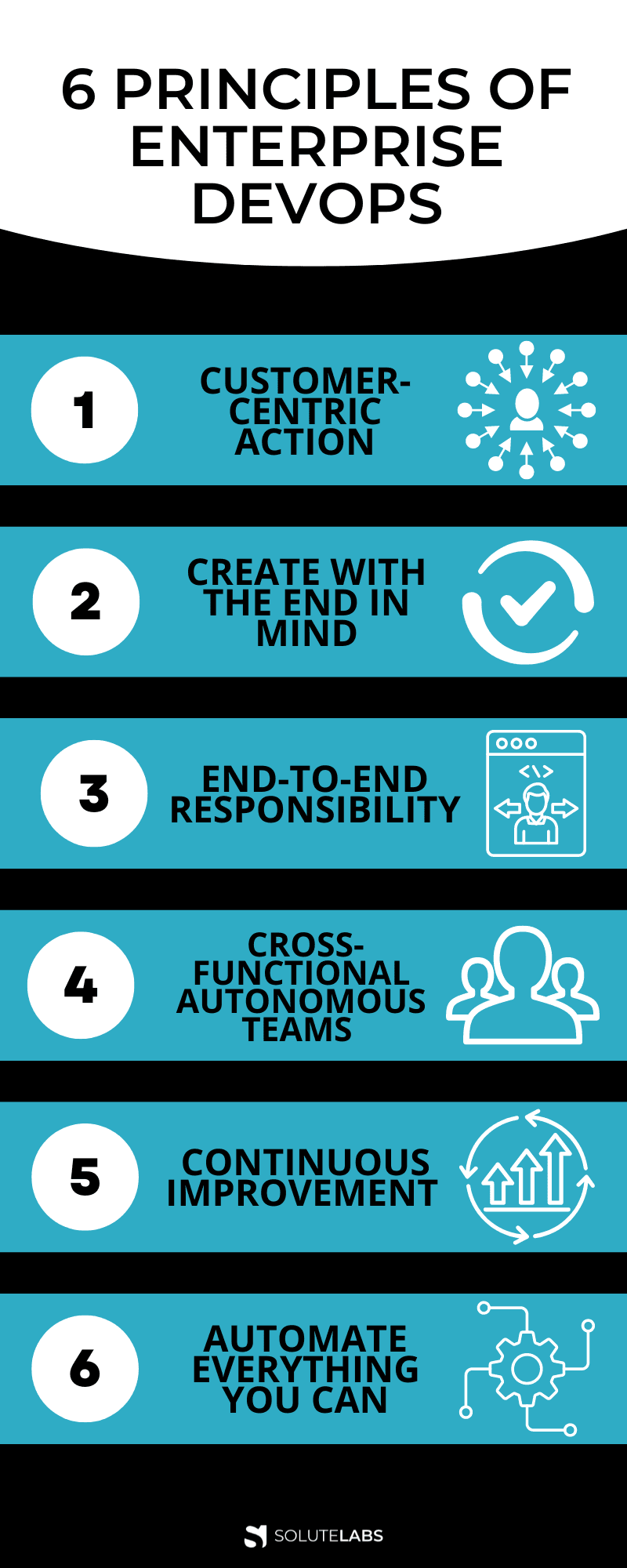In a multi-cloud world, being able to update and deploy applications rapidly is critical to the survival of every company. As a result, DevOps has become a buzzword that no longer holds just for the software industry but has quickly spread across companies big and small.
However, with this rapid increase in the demand for DevOps talent and the rapid growth of DevOps teams in recent years, there has been little information that fills the gaps between enterprises on how to run their successful DevOps programs.
In this article, we'll look at Enterprise DevOps and how it can help businesses in the long run.
What is Enterprise DevOps?
Enterprise DevOps is a set of practices and principles that help organizations create software faster and more efficiently. Essentially, it's a way to align the business and IT teams' goals to ensure that everyone is working toward the same goal.
Enterprise DevOps's primary goal is to ensure developers and IT pros can access the tools they need to do their jobs quickly. It also helps them work together more efficiently, so they don't waste time duplicating efforts or slowing each other's progress.
A DevOps team can improve efficiency in organizations through better use of data, automation of manual processes, decreased time to market for new products, increased customer satisfaction, and finding opportunities for cost reduction.
How does Enterprise DevOps work?
Enterprise DevOps strategy focuses on automating the software development environment and using tools to track and manage code changes throughout the cycle of software development and deployment. These tools identify problems early on so they can be addressed before they cause outages or other problems in production.
The goal here is to ensure that the code is deployed consistently across environments with minimal friction so that you can test new features quickly without having to wait for all the infrastructure to be built out manually by people who aren't familiar with the product.
Also, Read: Role of DevOps in Mobile App Development
Difference between Enterprise DevOps and DevOps
In enterprise-wide DevOps, an operations team provides a common set of virtual machine (VM) images or environments so that various development teams can automate them according to their own procedures and rates.
In a smaller DevOps environment, the development team creates the tools required to automate deployments to production in a smaller DevOps environment.
In the case of large, highly regulated enterprises, they face particular difficulties when scaling DevOps. These difficulties typically entail monolithic systems, outdated software, manual procedures, and other problems specific to huge businesses, which are naturally slower to adapt and more cumbersome to use due to their size and age.
Also, Read: DevOps vs Agile: What's the Difference?
Challenges faced by Enterprises
When we say "enterprise," we are referring to companies like international banks or massive retailers who handle large amounts of money or inventory on a daily basis.
Here are some of the common challenges that enterprises face:
- Change Control - For a release, there’s a change control procedure that must be followed for every change, no matter how minor.
- Approval Gates - Self-service deployments fueled by development on-demand, as promised by DevOps, might not be viable. A release team exists.
- Massive Environments - Your environments are extremely likely to be very large and unlikely to be amenable to rapid automation using technologies like Chef and Puppet if your program works with billions of transactions or users.
- Orchestration with Multiple Groups - Releases spanning several departments frequently occur simultaneously in large enterprises.
Why do Enterprise DevOps matter?
Enterprise DevOps matters because it’s the essential next step in the evolution of software development. The focus on rapid, reliable, and repeatable delivery of new features and capabilities has been a hallmark of the DevOps movement since its inception.
The DevOps movement changed all that. In enterprise DevOps, release managers are responsible for coordination, and developers are responsible for deploying their code into production. They use tools like Jenkins or Travis CI to automate the process, while IT admins provide services like databases and load balancers that developers need to do their jobs better.
Also, read: How can DevOps Outsourcing Benefit your Company?
DevOps Tools for enterprises
DevOps tools are applications that help make the process of developing and deploying software more efficient. Many different DevOps tools are available, and some are better suited for enterprises than others. We'll look at six popular DevOps tools that enterprises use to ramp up their business operations.
The following is a list of some of the most commonly used DevOps tools:
1. Jenkins
Jenkins is an open-source automation server that helps developers automate their jobs. It's used for continuous integration (CI), continuous delivery (CD), continuous deployment (CD), and more.
2. Git
Git is a version control system that tracks changes in computer files and folders over time, allowing users to revert to earlier versions if necessary. You can use Git to manage code on your computer or GitHub.
3. Amazon Web Services (AWS)
AWS is a cloud computing platform offered by Amazon that provides on-demand access to a broad set of computing services, including computing power, database storage, content delivery, and other functionality for developers at a low cost.
Also, Read: AWS vs Azure vs Google Cloud - Choose for your Enterprise
4. Slack
Slack is a messaging app for teams that lets you communicate with your team members through text, voice, and video calls. You can also use Slack as a personal productivity tool by creating reminders or setting up personal tasks for yourself in different channels.
5. Jira
Jira is an issue tracking tool that allows users to create issues that are then assigned to team members responsible for resolving them according to their priority level. Jira integrates with other applications so users can track issues across multiple programs simultaneously.
6. Nagios
An open-source monitoring tool allows you to monitor your infrastructure components (servers, networks, etc.) in real-time. Nagios offers numerous plugins enabling you to monitor any device or application, such as MySQL databases or Apache web servers.
6 Principles of Enterprise DevOps

Principle 1: Customer-Centric Action
Your company's customers expect fast, consistent, and reliable products. They also want to know that their experience with your product or service will be consistent across all channels and platforms, including mobile devices.
Your team needs to collaborate to deliver these outcomes that align with the customer experience. Everyone involved in building your web application must understand how customers will use it and how they can improve it based on those insights.
Principle 2: Create With The End In Mind
The second principle says we should design for production from the beginning. It's about thinking about how your application will work in production before developers write any code.
This principle is about ensuring that everyone involved in developing software has a shared understanding of what they're building and why they're building it that way.
Principle 3: End-To-End Responsibility
In DevOps for enterprise, all team members are responsible for delivering quality products from start to finish. This means that:
- Developers must be accountable for writing clean code that works as intended
- Testers must test thoroughly enough to ensure that each feature works as advertised
- Operations engineers must provide reliable environments for running applications at scale
If any team member fails at their job, it will affect the rest of the team's ability to successfully deliver its part of the product. It means that all of the members must deliver the desired quality.
Principle 4: Cross-Functional Autonomous Teams
In a traditional model, software development teams are organized into functional silos based on their work type. Enterprise devOps platform focuses on breaking down these silos to create cross-functional autonomous teams.
The teams are given complete ownership over their workflows, allowing them to decide how best to implement their work.
By eliminating bottlenecks and waiting time between phases in the software development lifecycle, cross-functional autonomous teams can move faster and be more flexible when responding to changes in requirements.
Principle 5: Continuous Improvement
Continuous improvement is essential to DevOps because it allows for rapid feedback and change.
In traditional environments, changes are often made on a schedule—monthly updates with bug fixes or new features; and quarterly upgrades introducing new technologies and APIs. In a DevOps environment, changes can happen daily, or even hourly if necessary. This enables fast iteration and adaptation to changing market conditions or user needs.
Continuous improvement is heavily emphasized to reduce waste, maximize speed, cost, and convenience of delivery, and continuously improve the provided goods and services.
Principle 6: Automate Everything You Can
DevOps relies on automation as a key component of its methodology. Automating your infrastructure means that you can scale up or down based on demand with little human intervention, which helps ensure your services' high availability and reliability.
Automation is important because it helps you reduce errors, save time, and improve the quality of your product or service.
DevOps automation is not only related to the software development process but also to the entire infrastructure landscape. It focuses on developing cutting-edge cloud platforms based on containers that enable infrastructure to be versioned and treated as code. Automation is connected to the need to modernize how the team provides its services.
Also, Read: How Does Cloud and DevOps Accelerate Digital Transformation
Ways for DevOps transformation in Enterprises
1. Start small
Enterprises need to start small to transform their organization into a DevOps organization. A large portion of the work they need to do is planning, training, and process creation.
The key to starting small is focusing on one team at a time. This way, enterprises can focus on making the right changes for them and allow them to become successful before moving on to the next team.
2. Improve communication
Organizations require communication tools that can compile information on the state of systems and software from both humans and machines. Understanding the nature of a problem and coordinating real-time responses should be made simple by the tools.
3. Better integrations
Businesses that rely on legacy software and find it difficult to coordinate activities across teams should make a change. They must integrate their software tools and workflows as much as they can. It will be more readily available when staff members require data.
4. More flexibility in roles
Engineers and IT Ops should have the knowledge and communication abilities to work with others outside their own fields of expertise.
5. Having the right tools
Building a toolbox that supports agility, collaboration, automation, communication, and legacy compatibility may be necessary for businesses looking to adopt DevOps.
6. Adopting a cultural change
It takes more than just installing the appropriate software to embrace DevOps. Businesses should decide on their goals for cultural transformation and then choose the software solutions that will help them get there.
Wrapping Up
The dream of emulating the speed of consumer DevOps in the enterprise is coming to fruition. As more and more businesses shift their focus online, there is growing pressure for these organizations to find workable solutions.
At its best, efficient Enterprise DevOps solutions can foster cooperation and collaboration for large-scale organizations to deliver better product development or services faster.








